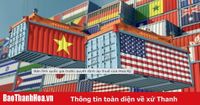The recent announcement by President Donald Trump regarding a 46% tax on Vietnamese exports to the United States has sparked significant concern and disappointment in Vietnam. This decision not only threatens to disrupt the economic relationship between the two nations but also raises alarms about the stability of global supply chains, where Vietnam plays a crucial role.
On April 2, 2025, Trump declared that a 10% tax would be applied to all imports entering the U.S., effective April 5, with higher tariffs for countries like Vietnam that maintain large trade surpluses. This move places Vietnam among the nations facing the steepest import tax, which could severely impact its economy.
According to reports, the rationale behind the high tax rate stems from allegations that Vietnam imposes a 90% tax on U.S. imports. However, this figure is contested and requires objective verification. Vietnam has consistently adhered to its international trade commitments, including those under the World Trade Organization (WTO) and various bilateral and multilateral trade agreements.
Prime Minister Pham Minh Chinh reacted swiftly to the tax announcement, convening an emergency meeting with relevant ministries and sectors on April 3, 2025. This meeting aimed to assess the immediate and long-term impacts of the new tariffs and to formulate responsive strategies. Chinh emphasized the need for a comprehensive evaluation of the effects on the economy, trade, employment, and market sentiment.
"Vietnam remains a reliable partner to the United States, committed to peaceful foreign policy and mutual development," Chinh stated. The government is prepared to engage in constructive dialogue and is determined not to resort to confrontation in international relations.
Experts warn that the high tariffs could adversely affect several key sectors of the Vietnamese economy. The textile industry, for instance, exports approximately $16.1 billion worth of products to the U.S., making up 43.6% of its total export value. With competitors like Bangladesh and India facing significantly lower tariffs, Vietnamese textile manufacturers may struggle to maintain their market share.
Similarly, Vietnam's exports of computers and electronic components, valued at $23.2 billion and accounting for 32% of total exports, could also be jeopardized. Many of these products come from foreign direct investment (FDI) firms such as Intel and HP, which might consider relocating some production to countries with lower tariffs.
Machinery and equipment, another vital export category, amount to $22 billion or 42.3% of Vietnam's exports. The imposition of high tariffs could diminish the competitiveness of these goods in the U.S. market.
Wood and wood products, which have a significant share of 56% in the export market, valued at $9.1 billion, face similar challenges. The increased costs associated with the tariffs could render Vietnamese wood products less competitive compared to imports from Canada and other countries that face lower duties.
Footwear, another major export worth $8.3 billion (36.2% share), is also at risk. The trend of companies relocating their manufacturing to Vietnam to reduce dependency on China may be reversed if tariffs on Vietnamese goods become prohibitive.
In the seafood sector, which exported $1.5 billion worth of products (18.2% share), the new tariffs could disrupt the current favorable conditions under which shrimp and pangasius are exported to the U.S. In 2024, Vietnam's shrimp exports to the U.S. reached $691 million, accounting for 18% of total shrimp exports, while pangasius exports were valued at $345 million, representing 17% of total exports.
Despite these challenges, experts suggest that this situation may catalyze a necessary transformation within Vietnam's export model. Rather than relying solely on assembly and processing, there is an urgent need to increase local content, develop supporting industries, and produce higher value-added products.
"This could be a wake-up call for Vietnam to accelerate its transition in the export model," noted economic analysts. The potential impact on foreign direct investment (FDI) could also reinforce the role of domestic private enterprises, which are becoming increasingly dynamic and innovative.
To secure economic growth in this new context, the government is urged to implement robust economic stimulus measures. These should focus on effective public investment, support for small and medium-sized enterprises, expansion of domestic markets, and promotion of consumption.
Moreover, the government is committed to expediting institutional reforms, including improvements in the business environment, administrative procedures, tax policies, and land use regulations. These reforms are essential not only for enhancing resilience but also for enabling Vietnam to seize growth opportunities.
In the face of adversity, Vietnam's history shows resilience against various economic shocks, from sanctions and financial crises to natural disasters and unexpected policy changes from major partners. Prime Minister Chinh emphasized the importance of maintaining composure and adaptability in response to external shocks.
"Tariffs may serve as a temporary barrier, but they cannot stifle the entrepreneurial spirit and adaptability of the Vietnamese people," he asserted. The world remains vast, filled with opportunities, and with a unified front from the government, businesses, and the populace, Vietnam can navigate these turbulent waters with confidence.
Ultimately, Vietnam continues to choose the path of peace, cooperation, and dialogue. As long as goodwill and mutual respect are upheld, no door is truly closed. This message resonates strongly not only within Vietnam but also to the international community as a whole.





